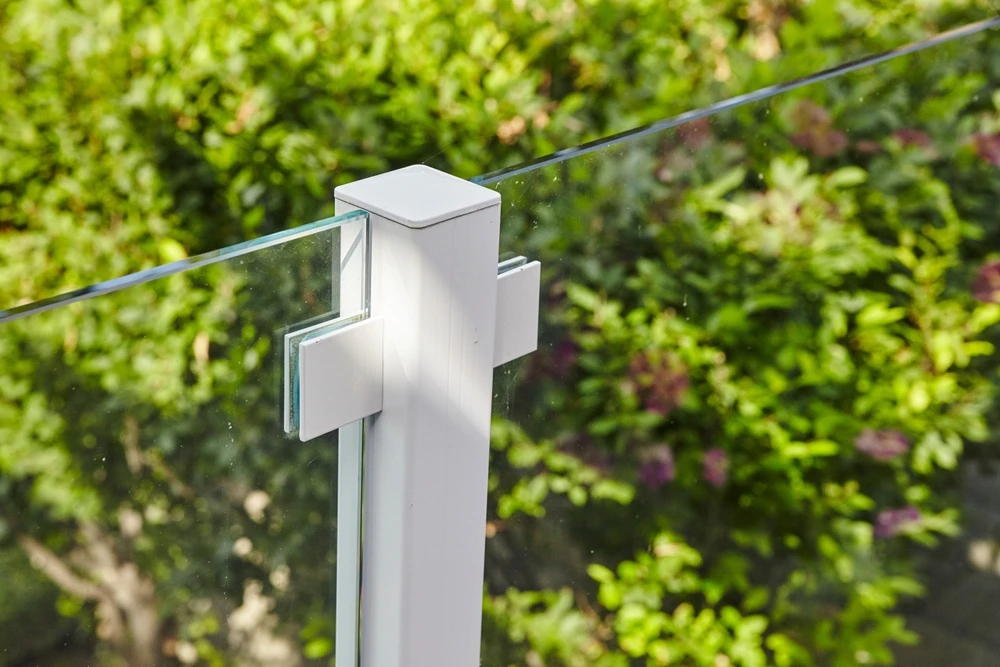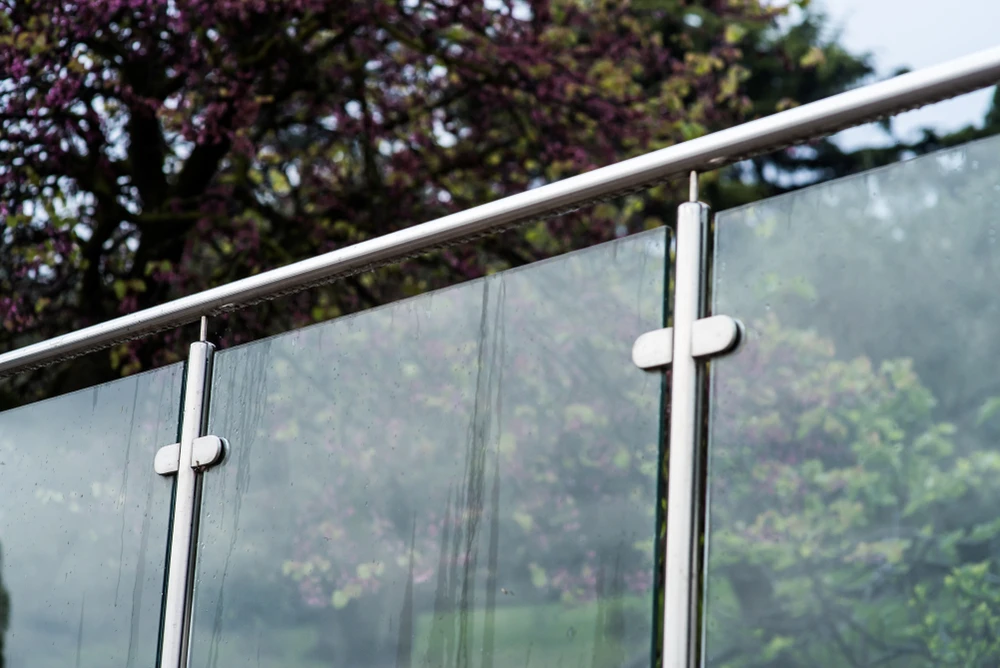How to Choose the Right Glass Fence for Your Outdoor Space
October 20, 2025

Products
balustrading
.webp)

locks and latches
.webp)

security and privacy
.webp)

Glass fencing has become one of the most sophisticated additions to modern outdoor living. It has evolved beyond simple boundary definition; it now combines style, safety and functionality to create open, bright and luxurious outdoor spaces. At Poolsafe Fencing, we’ve seen how a well-designed glass fence can completely transform an outdoor area, elevating backyards and pool zones into contemporary retreats that merge safety with elegance.
Whether you’re planning a new pool or upgrading your backyard, the right glass fence depends on knowing your options in design, safety, budget and maintenance. Below, we break down everything you need to know to make an informed, long-lasting choice.

Before you decide which glass fence is right for your space, it’s important to understand the different types available and what makes each unique. From seamless frameless designs to structured framed options, your choice should align with your lifestyle, style preferences and local conditions.
Frameless glass fencing represents the ultimate in modern outdoor design. This style uses thick, toughened glass panels held in place by small stainless-steel mounts, giving a completely open view of your pool or garden. The result is a minimalist design that enhances visual flow and gives your space a refined sense of openness. Frameless fencing is ideal for homeowners who want to highlight their pool area while keeping the focus on the surrounding scenery.
Semi-frameless fences offer strength and elegance, using slim vertical posts for subtle framing without blocking the view. In this design, glass panels are supported by vertical aluminium posts, creating a defined but still visually light boundary. This type of fence is often chosen by homeowners who want the elegance of glass but prefer added support for durability and cost efficiency. It’s an excellent choice for family homes and areas that experience moderate weather conditions.
Fully framed glass fencing combines the beauty of glass with maximum structural support. Each glass panel sits securely inside a full metal frame, making it sturdy enough for balconies, decks or windy areas. This design provides a more traditional aesthetic but with a modern twist. It’s often selected when durability and safety take precedence over full visual transparency.
Safety is the number one priority when installing glass fencing, especially around pools or family entertainment areas. Beyond looks, your fence must meet strict Australian standards to ensure it effectively protects children and pets without compromising accessibility or style. As experts, we always stress that true quality comes from systems that balance compliance, strength and design. Let’s look at some essential features that every homeowner should check before installation.
Every safe glass fence begins with the right material. Toughened glass, about 10 to 12 mm thick, is specially heat-treated to make it up to five times stronger than ordinary glass. When broken, it crumbles into small, blunt fragments rather than sharp shards, greatly reducing the risk of injury. Laminated options add an extra layer of protection, keeping fragments bonded together even upon impact.
A glass fence is only as safe as its gate system. Modern pool gates should close and latch automatically, keeping areas secure and meeting safety standards. For families with children, this feature is indispensable. It prevents unsupervised entry to pool areas and gives homeowners the peace of mind that safety is built into everyday use.
Attention to detail is crucial when it comes to family safety. Panels should have rounded edges to prevent cuts and fittings should be slip-resistant to stay stable on wet surfaces. Here are some additional safety tips:
A glass fence is a long-term investment that enhances safety and the overall value of your home. Knowing what affects cost helps you plan a realistic budget focused on quality and durability. Whether you’re choosing a frameless system or a more economical semi-frameless design, several elements will affect your final quote. Knowing these upfront helps you avoid surprises and ensures your investment delivers lasting returns.
When planning your glass fencing project, understanding what drives the total cost is essential. While glass panels draw most attention, hidden factors, like hardware and site preparation, often drive the total cost. Understanding these helps align your budget with your design goals. Knowing where to allocate your budget and where it’s worth spending a little more ensures your glass fence remains safe, beautiful and resilient for years to come.
Setting a budget isn’t just about keeping costs low; it’s about ensuring you get long-term value from your investment. Cheaper materials or installation often lead to rust, misalignment or premature wear that costs more to fix later. A balanced budget considers not just the price tag but also the return on durability. It’s crucial to think beyond initial expenses, so evaluate suppliers based on their materials, warranty coverage and reputation for compliance. Choosing the right installer and components upfront can save you significant costs over the life of your fence.
A high-quality glass fence enhances resale appeal by giving your outdoor area a sleek, resort-like finish that attracts modern buyers. From a maintenance perspective, glass fencing also delivers excellent returns compared to traditional materials. It resists corrosion, fading and warping, meaning fewer repairs and replacements over time. The ROI comes not only from durability but also from the added lifestyle value.

A professional glass fence installation is both a technical and aesthetic process. Knowing what to expect from consultation to completion keeps the process simple and stress-free. We guide clients through every stage, from planning layouts and measuring gradients to precisely fitting hardware. Here’s a closer look at what to expect during installation.
Every successful glass fencing project begins long before the first panel is installed. The site assessment and planning stage is where vision meets technical precision, ensuring your fence not only looks stunning but also complies with all local regulations and engineering requirements. This planning process allows for a smooth installation flow and minimises unexpected adjustments once work begins. A well-prepared plan ensures the finished fence seamlessly integrates into your landscape, enhancing both form and function.
Once the design and measurements are finalised, the next crucial stage is preparing the site to support the glass panels securely. Proper groundwork ensures the fence remains level, stable and safe for decades. Depending on your chosen system, this phase may involve core drilling into concrete, base-plate mounting on decking or channel fixing into prepared ground tracks. Installers also ensure that the base surface is smooth, clean and correctly levelled to provide uniform support. For sloped or uneven areas, custom mounting solutions are often used to maintain visual symmetry while adhering to safety standards. Proper ground preparation is the foundation of a flawless, durable installation.
The installation phase is where the transformation truly begins. Here, technical expertise and craftsmanship come together to create the sleek, modern aesthetic that defines glass fencing. Frameless systems rely on carefully positioned stainless-steel spigots or clamps that hold each panel firmly in place, while semi-frameless and framed systems use vertical posts and brackets for added stability. Attention to alignment is essential; even a minor tilt can disrupt the visual flow and compromise safety. By the time installation is complete, the fence should appear seamless and perfectly integrated into its surroundings.
After installation, the final stage involves testing, adjustments and certification to guarantee that your glass fence meets aesthetic expectations and strict Australian safety standards. This stage is more than a formality; it’s about ensuring long-term safety, durability and compliance. Installers inspect all fittings for tightness, confirm the self-closing action of gates and test for any potential movement in the panels. Once everything passes inspection, a compliance certificate is issued, confirming adherence to relevant standards. This final review gives homeowners the confidence that their new fence is not only beautiful but also built to last and protect.
Installing your glass fence is just the beginning. Proper care keeps it looking new and performing its best. While glass fencing is often praised for its minimal upkeep, it still requires regular care to preserve its clarity, shine and structural integrity. With the right approach, your glass fence will remain a striking feature of your outdoor space, combining safety, strength and lasting visual appeal without unnecessary maintenance stress.
Regular cleaning keeps your glass fence clear, strong and visually striking. Even though glass fencing is known for being low-maintenance, outdoor exposure means it will inevitably accumulate dust, mineral deposits and water stains, especially around pools or coastal areas. Over time, these buildups can dull the surface and reduce visibility if not addressed. By integrating cleaning into your seasonal home care, you’ll prevent long-term buildup and enjoy a crystal-clear barrier that complements your outdoor space all year round.
While the glass panels form the main visual feature of your fence, the unseen strength lies in the hardware that supports them. The metal parts that hold your fence carry all the weight, so moisture can loosen or rust them. Without regular inspection, these minor issues can evolve into serious safety risks or costly repairs. Here’s a maintenance checklist:
To extend its lifespan, apply protective coatings and schedule regular seasonal maintenance. Adding a protective glass coating helps water roll off easily, keeping dirt and chemicals from sticking. With a bit of foresight and attention, your glass fence will continue to perform safely while maintaining its sleek, modern appeal through every season.
The right glass fence strikes a balance between beauty, safety and everyday practicality. By understanding the different types, essential safety features and maintenance needs, you can make a confident decision that enhances your property’s value and visual appeal. At Poolsafe Fencing, we take pride in crafting fencing systems that not only meet compliance standards but also redefine outdoor elegance. Whether you’re designing a pool area, deck or garden boundary, our team can help you design a glass fence that perfectly fits your home, budget and the way you live.